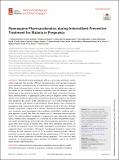| dc.contributor.author | Palang Chotsiri, Julie R Gutman, Rukhsana Ahmed, Jeanne Rini Poespoprodjo, Din Syafruddin, Carole Khairallah, Puji BS Asih, Anne L’lanziva, Kephas Otieno, Simon Kariuki, Peter Ouma, Vincent Were, Abraham Katana, Ric N Price, Meghna Desai, Feiko O Ter Kuile, Joel Tarning | |
| dc.date.accessioned | 2021-06-10T07:42:15Z | |
| dc.date.available | 2021-06-10T07:42:15Z | |
| dc.date.issued | 2021 | |
| dc.identifier.uri | https://repository.maseno.ac.ke/handle/123456789/3945 | |
| dc.description.abstract | Dihydroartemisinin-piperaquine (DP) is a long-acting artemisinin combination treatment that provides effective chemoprevention and has been proposed
as an alternative antimalarial drug for intermittent preventive therapy in pregnancy
(IPTp). Several pharmacokinetic studies have shown that dose adjustment may not
be needed for the treatment of malaria in pregnancy with DP. However, there are
limited data on the optimal dosing for IPTp. This study aimed to evaluate the population pharmacokinetics of piperaquine given as IPTp in pregnant women. Pregnant
women were enrolled in clinical trials conducted in Kenya and Indonesia and treated
with standard 3-day courses of DP, administered in 4- to 8-week intervals from the
second trimester until delivery. Pharmacokinetic blood samples were collected for
piperaquine drug measurements before each treatment round, at the time of breakthrough symptomatic malaria, and at delivery. Piperaquine population pharmacokinetic properties were investigated using nonlinear mixed-effects modeling with a
prior approach. In total, data from 366 Kenyan and 101 Indonesian women were analyzed. The pharmacokinetic properties of piperaquine were adequately described
using a flexible transit absorption (n = 5) followed by a three-compartment disposition model. Gestational age did not affect the pharmacokinetic parameters of piperaquine. After three rounds of monthly IPTp, 9.45% (95% confidence interval [CI], 1.8
to 26.5%) of pregnant women had trough piperaquine concentrations below the
suggested target concentration (10.3 ng/ml). Translational simulations suggest that
providing the full treatment course of DP at monthly intervals provides sufficient
protection to prevent malaria infection. Monthly administration of DP has the potential to offer optimal prevention of malaria during pregnancy. (This study has been
registered at ClinicalTrials.gov under identifier NCT01669941 and in the ISRCTN
under number ISRCTN34010937.) | en_US |
| dc.publisher | American Society for Microbiology | en_US |
| dc.subject | dihydroartemisinin-piperaquine, population pharmacokinetic model, intermittent preventive treatment in pregnancy, nonlinear mixed-effects modeling | en_US |
| dc.title | Piperaquine pharmacokinetics during intermittent preventive treatment for malaria in pregnancy | en_US |
| dc.type | Article | en_US |

